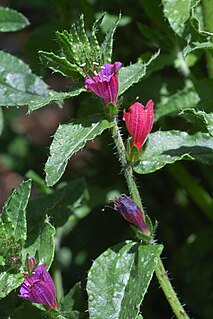Hydrophis viperinus, the viperine sea snake, is a species of Elapidae and Thalassophina viperina is its synonym. It is thought to be naturally rare but widespread. It is venomous.
Semiopyla is a spider genus of the Salticidae family.

The Antioch Pines Natural Area Preserve is a 1,017-acre (4.12 km2) Natural Area Preserve located along the Blackwater River near Zuni, Virginia. It contains growths of loblolly pine and turkey oak, and supports various species that are rare in Virginia, including Plukenet's flatsedge, sandy-woods chaffhead and viperina; in addition, swales support various species of wildflowers, including orchids, trilliums, bellworts and lilies. Also on the property are a pair of longleaf pines which represent some of the last of the species in Virginia; they are currently the subject of a breeding program by the Virginia Department of Forestry designed to restore the pines to their former habitat.

Echium tuberculatum (viperina) is a flowering plant from Portugal. This plant is a hardy garden perennial and it forms a sprawling mass of red flowers during the whole of the summer.

Oberea is a genus of longhorn beetles, most of which are stem borers of various plants, including blackberries and their relatives.
Oberea bisbipunctata is a species of flat-faced longhorn beetle in the tribe Saperdini in the genus Oberea, discovered by Maurice Pic in 1916.
Echiomima is a genus of moths of the Xyloryctidae family.
Echiomima viperina is a moth in the Xyloryctidae family. It was described by Meyrick in 1915. It is found in Australia, where it has been recorded from Queensland.
Oberea nyassana is a species of beetle in the family Cerambycidae. It was described by Stephan von Breuning in 1956.
Oberea consentanea is a species of beetle in the family Cerambycidae. It was described by Francis Polkinghorne Pascoe in 1867. It is known from Borneo.
Oberea inclusa is a species of beetle in the family Cerambycidae. It was described by Francis Polkinghorne Pascoe in 1858. It contains the varietas Oberea inclusa var. discipennis.
Oberea rubetra is a species of beetle in the family Cerambycidae. It was described by Francis Polkinghorne Pascoe in 1858. It is known from Sumatra, Borneo and Malaysia.
Oberea neavei is a species of beetle in the family Cerambycidae. It was described by Per Olof Christopher Aurivillius in 1914.
Oberea erythrostoma is a species of beetle in the family Cerambycidae. It was described by Heller in 1915. It is known from the Philippines.
Oberea ferruginea is a species of beetle in the family Cerambycidae. It was described by Thunberg in 1787.
Oberea fuscipennis is a species of beetle in the family Cerambycidae. It was described by Chevrolat in 1852.
Oberea griseopennis is a species of beetle in the family Cerambycidae. It was described by Bernhard Schwarzer in 1925. It feeds on Cinnamomum camphora.
Oberea linearis is a species of beetle in the family Cerambycidae. It was described by Carl Linnaeus in 1761, originally under the genus Cerambyx. It has a wide distribution throughout Europe. It is preyed upon by Opilo pallidus, and serves as a host for the parasitic wasp species Dolichomitus messor and Phaenolobus terebrator. It feeds on Juglans regia, Corylus avellana, Ulmus glabra, Ostrya carpinifolia, and Carpinus betulus. It contains the varietas Oberea linearis var. parallela.
Oberea vittata is a species of beetle in the family Cerambycidae. It was described by Blessig in 1873. It is known from Russia, China, Mongolia, and Japan.



